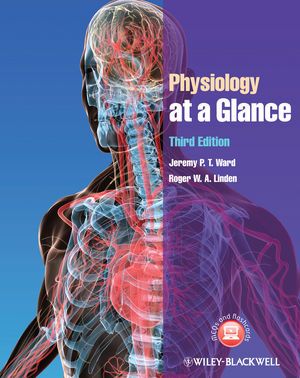Physiology at a Glance, 3rd Edition
by Jeremy P. T. Ward, Roger W. A. Linden-
Paperback
KWD14.180
This revised and updated edition of Physiology at a Glance features clear and concise illustrations, memorable data tables, and easy-to-read text, to provide a thorough introduction to physiology that integrates seamlessly with the medical school curriculum.
Physiology at a Glance breaks the topic down into its core components, dealing with structures of the body from cellular level to composite systems. Each chapter focuses on an element of the body and explores vital concepts to aid students at all levels of their training.
Physiology at a Glance:
• Introduces basic biological principles in easy-to-follow spreads, followed by thoroughly revised and updated systems-based chapters
• Features completely revised or brand new chapters and figures, including introductory chapters on homeostasis, blood, haemostasis and immunological defence mechanisms
• Is fully supported by a companion website at www.ataglanceseries.com/physiology featuring online access to over 200 self-assessment questions from the book, downloadable flashcards, and revision notes
With its straightforward approach to explaining the functions of the body, Physiology at a Glance provides medical, dental, health science and biomedical students with a thorough understanding of an often complex subject.
Description
This revised and updated edition of Physiology at a Glance features clear and concise illustrations, memorable data tables, and easy-to-read text, to provide a thorough introduction to physiology that integrates seamlessly with the medical school curriculum.
Physiology at a Glance breaks the topic down into its core components, dealing with structures of the body from cellular level to composite systems. Each chapter focuses on an element of the body and explores vital concepts to aid students at all levels of their training.
Physiology at a Glance:
• Introduces basic biological principles in easy-to-follow spreads, followed by thoroughly revised and updated systems-based chapters
• Features completely revised or brand new chapters and figures, including introductory chapters on homeostasis, blood, haemostasis and immunological defence mechanisms
• Is fully supported by a companion website at www.ataglanceseries.com/physiology featuring online access to over 200 self-assessment questions from the book, downloadable flashcards, and revision notes
With its straightforward approach to explaining the functions of the body, Physiology at a Glance provides medical, dental, health science and biomedical students with a thorough understanding of an often complex subject.
Table of Contents
Preface 7
Acknowledgements 7
List of abbreviations 8
About the companion website 11
Part 1
Introduction
1 Homeostasis and the physiology of proteins 12
2 Body water compartments and physiological fl uids 14
3 Cells, membranes and organelles 16
4 Membrane transport proteins and ion channels 18
5 Biological electricity 20
6 Conduction of action potentials 22
7 The autonomic nervous system 24
8 Blood 26
9 Platelets and haemostasis 28
10 Defence: Inflammation and immunity 30
11 Principles of diffusion and flow 32
Part 2
Muscles
12 Skeletal muscle and its contraction 34
13 Neuromuscular junction and whole muscle contraction 36
14 Motor units, recruitment and summation 38
15 Cardiac and smooth muscle 40
Part 3
The cardiovascular system
16 Introduction to the cardiovascular system 42
17 The heart 44
18 The cardiac cycle 46
19 Initiation of the heart beat and excitation–contraction coupling 48
20 Control of cardiac output and Starling’s law of the heart 50
21 Blood vessels 52
22 Control of blood pressure and blood volume 54
23 The microcirculation, fi ltration and lymphatics 56
24 Local control of blood fl ow and special circulations 58
Part 4
The respiratory system
25 Introduction to the respiratory system 60
26 Lung mechanics 62
27 Transport of gases and the gas laws 64
28 Carriage of oxygen and carbon dioxide by the blood 66
29 Control of breathing 68
30 Ventilation–perfusion matching and right to left shunts 70
Part 5
The renal system
31 Introduction to the renal system 72
32 Renal filtration 74
33 Reabsorption, secretion and the proximal tubule 76
34 The loop of Henle and distal nephron 78
35 Regulation of plasma osmolality and fl uid volume 80
36 Control of acid–base status 82
Part 6
The gut and metabolism
37 Gastrointestinal tract: overview and the mouth 84
38 Oesophagus and stomach 86
39 Small intestine 88
40 The exocrine pancreas, liver and gallbladder 90
41 Large intestine 92
Part 7
Endocrinology and reproduction
42 Endocrine control 94
43 Control of metabolic fuels 96
44 The hypothalamus and pituitary gland 98
45 Thyroid hormones and metabolic rate 100
46 Growth factors 102
47 Somatic and skeletal growth 104
48 Control of plasma calcium 106
49 The adrenal glands and stress 108
50 Endocrine control of reproduction 110
51 Sexual differentiation and function 112
52 Fertilization, pregnancy and parturition 114
53 Lactation 116
Part 8
The sensory and motor systems
54 Introduction to sensory systems 118
55 Sensory receptors 120
56 Special senses: Taste and smell 122
57 Special senses: Vision 124
58 Special senses: Hearing and balance 126
59 Motor control and the cerebellum 128
60 Proprioception and refl exes 130
Part 9
Self-assessment
Self-assessment MCQs 132
Answers to self-assessment MCQs 148
Appendix I: Comparison of the properties of skeletal, cardiac and smooth muscle 149
Appendix II: Normal physiological values 150
Index 153


